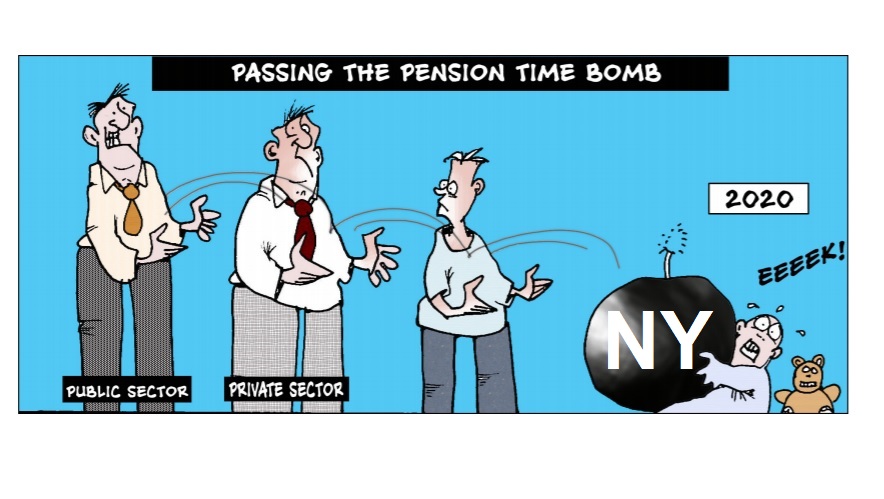For decades warnings of New York’s disastrous pension fund have been in the radar of analysis and politicians, but the rhetorical answer has been to raise taxes for all New Yorker’s while retirees enjoy their cruise ship vacations and southern life styles. New York’s pension fund is by far one of the states largest syphon of economic resources and a welfare program that New Yorkers simply can’t afford in it’s current form. This is not just a state issue, New York City’s pension liability accounts for 75% of it’s whopping $197.8 billion deficit. Very difficulty to see how this meets any good accountability practice, by any standard, many fear possible bankruptcy in the near future.
For those who are not paying attention, gaming New York’s pension system has become an art for many public servants that has significantly contributed to the problem, which in turn has fuel tax increases, rising of the cost of living in New York and making it less attractive for pensioned retirees to stay in the state during their golden years. So not only is the public pension reducing disposal income for current New Yorker’s in the state, cities and counties, most of the monies don’t stay long enough to at a minimum circulate and contribute to the local economy. Worst, many have taken early retirement which exacerbates the rising cost to New Yorkers sooner rather than later. Individually, they may not see that they contribute to the problem, but collectively its a major hull to tax payers and both city and state budgets. Leaving less funds for education and other critical services.
According to a report from the Center for Cost Effective Government, state and local employees who pad their pension payments by building up overtime as they near retirement could cost taxpayers a whopping $32 billion to $54 billion over the next 20 years. With inflation, that figure might jump to $84 billion in addition to the fund deficit that needs no help in increasingly burying itself in the red.
That’s a lot of money, even for New York.
Now with the anticipated aftermath of the Coronavirus pandemic, one can only imaging the stress to the retirement system is going to be that much more greater. It is anticipated that similar to the subsequent years immediately following the September 11th terror attacks, many public frontline personnel are going to seek out early retirement due to the current crisis.
While for many retiring early may be well deserved, this will also mean less available funds for other social programs like public housing, homeless shelters, drug addiction intervention, education and even less monies for those who are currently employed. In addition, for law makers in Albany the answer seems to be simple by continuing to dig into every New Yorkers pocket with the stroke of the pen.
Pension payouts are usually based on an employee’s three highest earning years, including overtime. So workers close to retirement juice their salaries by putting in extra hours, with many union contracts giving senior employees first crack at the OT.
State law now caps overtime pay used in pension calculations but only for workers hired after 2012. Passing a cap for all employees would require a change to the state Constitution.
As a result, “six-figure pensions are now quite common,” the center noted. Indeed, three-quarters of Nassau and Suffolk County cops who retired last year got more than $100,000 annual pensions; so did two-thirds of Yonkers police retirees.
One 52-year-old Nassau officer retired with a $221,086 annual package — after ending his career with a base salary of $122,514.
Last spring, The Post highlighted even higher payouts for LIRR workers, based on figures provided by the Empire Center.
There’s genuine incentive and conflict of interest for law makers when dealing with pension issues. The problems is that sweetening the pot for public workers and unions is an easy way to gain votes with little to no individual consequence to the politicians who personally benefit from the deals they cut. Deals with no regard for the majority of citizens who are not privileged by the benefits of a government job. In addition, common citizens are often sympathetic to improving public employee benefits without understanding how they are left to flip the bill.
But dealing with future pensions is simply not enough, as legacy pensions bare the brunt of years of New York leaders simply looking the other way and many times helping to contribute to the problem of pension unsustainability. Their split between throwing enough money around to surely live another day in public office, or do the right thing by properly managing public finances and risk been looked at as the grim ripper. So for years it’s just been easier for leaders down from New York City to all the up to the state Governor to pass the burden to future generations and hope the bomb doesn’t blow up in their watch.

COMMENTS